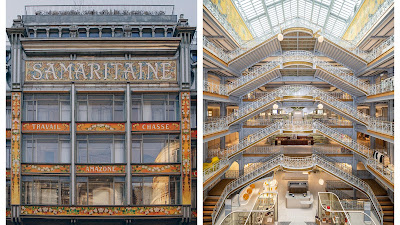"Below stairs", a wall of ironstone bowls and gleaming copper pans in the kitchen stretches practically the length of the room. Through the little hutch on the left, the staff dining room is set for their midday meal.
Across from the wall of copper pans, the massive kitchen stove stands center stage, with the large ovens to the right. One can only imagine the sumptuous feasts that were created here. Möise was known for his lavish dinners, served on exquisite Buffon dishes decorated with beautiful ornithological drawings, and made for him by the Sèvres ceramic factory.
Sadly, the pleasure this world offered to Möise de Camondo did not last. At the outbreak of WWI, his only son, Nissim de Camondo, was recalled back into the military. He became one of the most renowned pilots of the war until 1917, when his plane was shot down over Lorraine.
Heartbroken after his son's death, Möise de Camondo closed all his banking activities. He largely withdrew from society and devoted himself primarily to his collection, and to hosting occasional dinner gatherings. He arranged for his home to be donated, on his death, to Paris' Decorative Arts Society as a museum. He stipulated in his will that nothing was to be moved in the house, "Don't lend things. Keep the blinds down, keep the dust away, don't add objects to these collections." In 1936, following his death the previous year, the Musée Nissim de Camondo opened its doors, named in memory both of his fallen son and his father, who shared the same name. When his daughter, Béatrice, her husband, Léon and their two children were arrested by the Gestapo in 1942, and sent to Auschwitz where they died, the museum became a memorial to them as well.
For eighty-five years nothing has changed. Until last year, when the acclaimed English ceramicist and writer, Edmund de Waal, was invited by the museum to weave some of his contemporary porcelain works into the fabric of this home. Well known for his best-seller The Hare with Amber Eyes, dedicated to his family's history, de Waal is related to the Camondo family. His grandmother's family, the fabled Ephrussi's, lived just ten doors up on the rue de Monceau. They were cousins of the Camondo's. They shared the same banking success, and the same love for the arts. They also shared loss and tragedy. De Waal found himself visiting the museum over and over, soaking in the beauty of the collection and the sorrow of the family. Following these visits, he began writing letters to Möise: "About collecting, about being Jewish, about food and dogs and Proust and family and belonging. And mourning." They're messages from the future to a long-lost relative. These letters eventually became a book, Letters to Camondo, and led to the current exhibition at the museum: Lettres à Camondo. It can best be described as the artist's way of weaving connections between his own life and the lives of others.
...others are half hidden, tucked behind a hutch door off the scullery...
...and still others are slipped inside a drawer of this table decorated with Sèvres porcelain plaques. De Waal's work is minimalist, even austere, in contrast to the colorful richness of 18th century furnishings.
In the large porcelain room, small shards are placed in bowls, as if to keep the magnificent Buffon birds company. They're made of porcelain with red iron oxide, gold and lead. Some have letters or words on them. "I find this difficult" can be seen on one. They're like broken fragments of lost dreams.
The circular, wood-panelled library has an inviting, warm feeling. Sofas, comfortable chairs, another beautiful carpet...
Perhaps most poignant, on Möise de Camondo's desk in the large study, a small stack of porcelain "letters", the link the artist seeks between the generations.
In the courtyard are eight stone benches, made from Hornton stone, golden-brown with dark bands running through them. A few have small gilded lead folds on the edges. De Waal describes them as "my form of kintsugi, the manner in which some broken porcelain in China and Japan are repaired with lacquer and gold, a way of marking loss."
The short term presence of these contemporary porcelain objects amidst the 18th century splendor of Möise de Camondo's home, the personal bond between the artist and the Camondo family, confirm it forever as a place of remembrance. As de Waal says "You cannot mend this house or this family. You can mark some of the broken places. You can mark them properly and with dignity, with love. And then move away again, let the house be."
As we slowly walked away from the museum and its compelling story, the magnolia blossoms that are bursting out everywhere offered some comfort that in these troubling times, we can at least still count on Mother Nature to follow her reliable passage of the seasons.
Au Revoir!
Follow @JanetRobbins14

































































